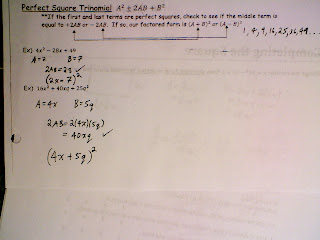Learning Goals: Distinguish between linear and quadratic functions.
We began today by reviewing some of yesterday's homework. Be sure you are clear on what a function is.
Then I discussed how to use set notation to write down the Domain and Range of a function.
If the function is given as a set of ordered pairs, we just need to list the values,
Example: What is the domain and range of the following function,
(2, 3) (3,6) (4, 8) (5, 3) (6, 3)
Solution: D = {2, 3, 4, 5, 6} R = {3, 6, 8}
If we have a graph the domain and range is a bit more tricky.
Example: What is the domain and range of the following function?
Solution: The domain, x, can be any value. In set notation we write this as,
In words, we read this as "The domain is x in the real numbers".
The range, y, can only be positive. In set notation we write this as,
In words we say, "The range is y in the real numbers, such that y is greater than 0."
Next we talked about linear and quadratic functions. These are two kinds of functions that we will be studying a lot of throughout the course.
If you are given a function as a table of values, you can tell if it is linear, quadratic or neither, by finding the first or second differences.
 |
| The first differences are the same, therefore this function is linear. |
 |
| The second differences are the same, therefore this function is quadratic. |
You can also tell by looking at the equation. If the equation has degree 1, then it is linear. if it has a degree of 2, it is quadratic.
Example: y = mx + b
This is linear because it has degree 1.
Example: y = ax² + bx + c
This equation is quadratic because of the x² it has a degree of 2.
For homework, please work on page 24, #1-9 (photocopied).














































